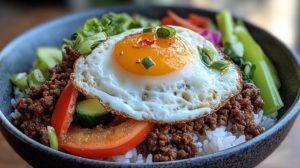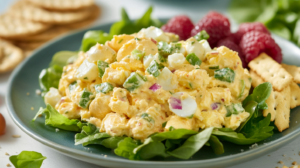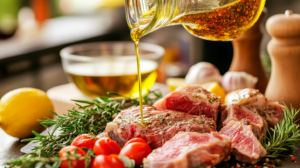What Makes a Ribeye Steak So Perfect Anyway?
A perfectly cooked ribeye steak is pure satisfaction on a plate. Juicy, flavorful, and incredibly tender, the ribeye is often considered the king of steaks—and for good reason. Whether you’re cooking indoors on a cast iron skillet or outdoors on a blazing grill, this cut delivers that buttery texture and bold beefiness that steak lovers crave.
But here’s the deal: while it may seem intimidating, cooking the perfect ribeye steak at home is totally doable. All you need is the right cut, a little technique, and a few insider secrets. This guide will walk you through everything from selecting a high-quality ribeye, seasoning it like a pro, cooking it to perfection, and even serving it with the best side dishes and wines.
We’ll also cover some common mistakes to avoid and how to store and reheat your leftovers without losing that signature flavor. Whether you’re a steak novice or a seasoned home chef, this is your all-in-one playbook for getting it right—every single time.
Check out this guide on how to grill indoors like a pro if you’re limited on outdoor space.
Ready to turn your kitchen into a five-star steakhouse? Let’s start with what makes a ribeye steak truly perfect.
Table of Contents
Table of Contents
What Makes the Perfect Ribeye Steak?
Ribeye vs. Other Cuts: Why It’s the King of Steaks
Not all steaks are created equal. While filet mignon and New York strip have their fans, the ribeye steak stands in a class of its own. Cut from the rib section of the cow—specifically between ribs 6 and 12—the ribeye is known for its intense marbling, rich flavor, and melt-in-your-mouth texture.
What makes the ribeye unique is its perfect balance of fat and meat. The fat isn’t just around the edges; it’s woven through the muscle fibers in fine, white lines known as marbling. As the steak cooks, this fat melts and naturally bastes the meat, creating a buttery texture that’s full of flavor.
Here’s how ribeye compares with other popular cuts:
| Steak Cut | Marbling | Tenderness | Flavor Profile |
|---|---|---|---|
| Ribeye | High | Very Tender | Rich, Beefy, Buttery |
| Filet Mignon | Low | Extremely Tender | Mild, Subtle |
| New York Strip | Medium | Tender | Bold, Meaty |
| Sirloin | Low | Moderate | Lean, Slightly Chewy |
Discover great ideas like ribeye vs sirloin comparison if you’re trying to pick the right cut for your next dinner.
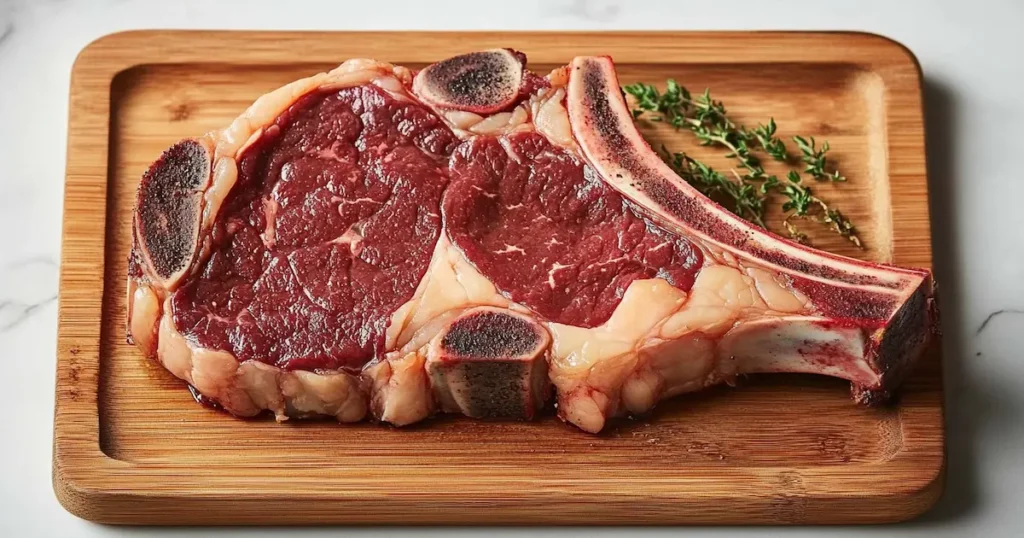
Marbling Magic: The Secret Behind Flavor and Juiciness
If you’re wondering what gives the ribeye steak its incredible juiciness and flavor, the answer lies in one word: marbling. This intramuscular fat is the hallmark of a high-quality steak and is one of the main reasons ribeye is such a standout choice.
When marbling melts during cooking, it seeps into the surrounding muscle fibers. This keeps the meat tender and infuses every bite with deep, rich flavor. The more marbling, the more mouthwatering your steak will be.
The USDA grading system actually ranks beef based on the level of marbling:
| USDA Grade | Marbling Level | What It Means |
|---|---|---|
| Prime | Heavy | Best quality, superior juiciness |
| Choice | Moderate | Great quality, widely available |
| Select | Low | Leaner, often less flavorful |
If you’re going for gold, choose a USDA Prime ribeye. But even USDA Choice can deliver great results with the right technique.
Check out our marbling visual guide to spot the best cuts at your local butcher.
The Perfect Ribeye Steak
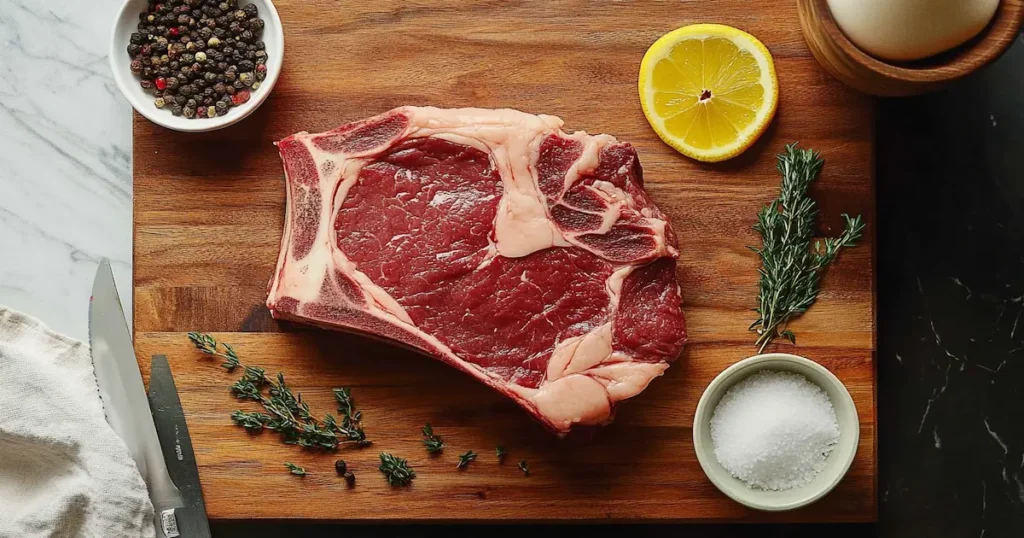
How to Choose the Best Ribeye Steak at the Butcher Shop
USDA Grades: Prime, Choice, or Select?
When it comes to choosing the right ribeye steak, you can’t ignore the USDA grade. This label tells you everything you need to know about the steak’s quality and flavor potential.
- Prime: The highest grade, found in top steakhouses. Expect intense marbling, superior tenderness, and bold flavor. Perfect for pan-searing or grilling.
- Choice: A solid, widely available option. It has moderate marbling and is still flavorful when cooked properly.
- Select: Lean and more budget-friendly. It lacks the fat that makes ribeye so tender, so it’s best if you plan to use a marinade.
No matter your choice, look for steaks that are bright red with white streaks of marbling throughout the meat. Avoid any cuts with brown spots or dry-looking edges.
Pro Tip: Thicker is better. Aim for a ribeye that’s at least 1.25 to 1.5 inches thick for better control over doneness.
The Perfect Ribeye Steak
Bone-in or Boneless Ribeye: Which One to Pick and Why
Now that you’ve selected the grade, there’s another decision to make—bone-in or boneless?
Each version has its pros and cons:
- Bone-in Ribeye (aka Cowboy or Tomahawk):
- Adds flavor during cooking
- Slower, more even heat distribution
- Looks dramatic and rustic on the plate
- Boneless Ribeye:
- Easier to cook evenly
- Quicker cook time
- More meat, less waste
If you’re aiming for a luxurious dining experience or presentation, go bone-in. If convenience and simplicity are your priorities, boneless is the way to go.
Looking for inspiration? Try our tomahawk steak technique for mastering bone-in cuts.
The Perfect Ribeye Steak
Here’s a quick comparison chart:
| Type | Ease of Cooking | Flavor Depth | Cooking Time | Presentation |
|---|---|---|---|---|
| Bone-In | Moderate | Higher | Slower | Very Impressive |
| Boneless | Easy | Still Great | Faster | Classic |
Remember: regardless of type, freshness and marbling matter most. Build your ribeye on the foundation of quality, and you’re already halfway to perfection.
Essential Equipment for Cooking the Perfect Ribeye
Cast Iron Skillet vs. Grill: Which is Best for Ribeye?
Choosing the right cooking surface is key when it comes to mastering the perfect ribeye steak. Your main two options? Cast iron skillet and grill. Each has its perks, and the best choice depends on your cooking style, space, and flavor preference.
- Cast Iron Skillet:
- Retains heat extremely well for a beautiful, even sear.
- Ideal for indoor cooking, especially during cold seasons.
- Perfect for techniques like butter basting.
- Grill (Gas or Charcoal):
- Adds a smoky, charred flavor that’s hard to beat.
- Best for summer cookouts and open flame lovers.
- Allows for reverse sear with indirect heat zones.
So which should you pick? If you want full control and crust, go cast iron. If you’re craving smokiness and grill marks, fire it up outside.
Check out our cast iron ribeye technique for indoor mastery.
The Perfect Ribeye Steak
Must-Have Tools for Temperature and Searing
Steak success depends not just on the meat but on the tools you use. Here are some essential tools every steak lover should have on hand:
- Instant-read thermometer: Ensures your steak hits the perfect internal temperature.
- Long-handled tongs: For flipping without piercing the meat.
- Heavy-duty cast iron pan or grill grate: Retains high heat and leaves a serious sear.
- High-smoke point oil: Choose avocado, canola, or grapeseed for a clean sear.
- Basting brush or spoon: For that mouthwatering butter baste.
Bonus tip: Use a meat thermometer with a probe if you’re going for reverse searing. This helps you monitor doneness with zero guesswork.
The Perfect Ribeye Steak
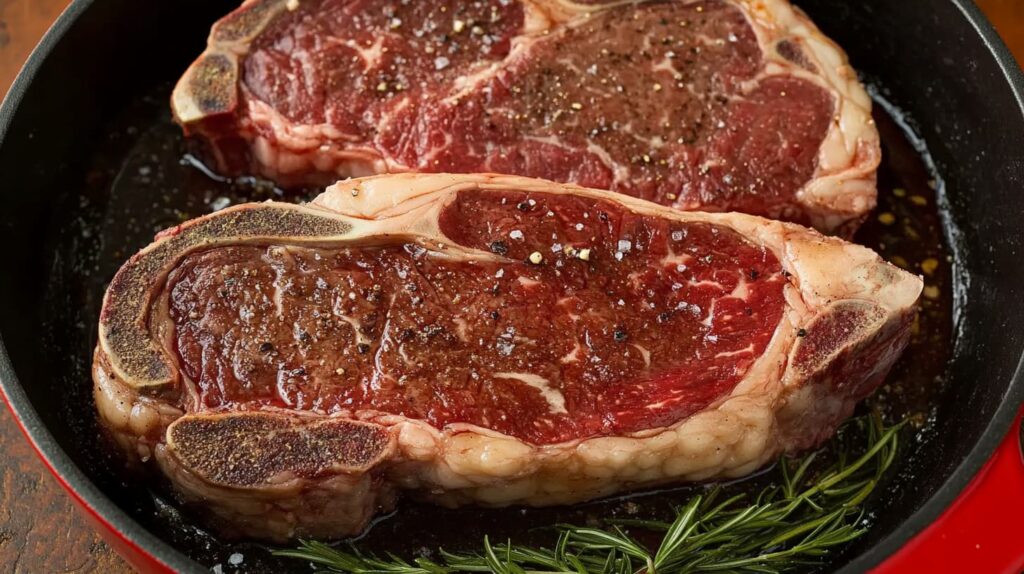
Prepping Your Ribeye Steak Before Cooking
The Art of Seasoning: Salt, Pepper, and Beyond
When it comes to seasoning ribeye, simplicity is your best friend. You want to highlight the beef’s natural flavor, not mask it.
- Start with kosher salt and freshly ground black pepper. Apply generously on both sides, pressing it into the meat.
- Want to enhance the flavor even more? Add:
- Garlic powder
- Smoked paprika
- Crushed rosemary
- A touch of chili flakes
Avoid wet marinades unless your steak is lean or low-quality (like Select grade). Ribeye has enough fat and flavor to stand on its own.
Discover great ideas like DIY steak rubs if you want to mix things up.
The Perfect Ribeye Steak
Letting It Rest: Why Room Temperature Matters
Before cooking, let your seasoned ribeye rest at room temperature for 30 to 60 minutes. Why?
- It ensures even cooking—no cold centers.
- It helps you get a better sear because moisture evaporates slightly, letting the crust develop.
Cold steaks thrown straight from the fridge onto a pan tend to cook unevenly and steam instead of sear. Don’t skip this simple but crucial step.
Bonus: If time allows, season your ribeye the night before, wrap loosely, and refrigerate uncovered. This dry brine process draws moisture to the surface, dissolves the salt, and locks in flavor.
The Perfect Ribeye Steak
Cooking the Perfect Ribeye Steak: Step-by-Step Guide
Now that your ribeye is seasoned and rested, it’s time for the fun part: cooking. Here are two tried-and-true methods to get a perfect finish every time.
Pan-Searing: Achieving the Perfect Crust
This is the most common and reliable method, especially for indoor cooking.
Steps:
- Preheat your skillet over medium-high heat until it’s smoking hot (literally).
- Add high-smoke point oil to the pan—just enough to coat the bottom.
- Gently lay your ribeye in the skillet, away from you to avoid splatter.
- Sear each side for 2–3 minutes, pressing down gently for even contact.
- Reduce heat to medium. Add 2 tbsp butter, 2 garlic cloves (smashed), and fresh thyme or rosemary.
- Baste the steak by tilting the pan and spooning the butter over the meat for 1–2 minutes.
- Check internal temp. Pull off heat when it’s 5°F below your desired doneness.
- Let it rest for 5–10 minutes.
That’s it. You’ll get a crusty, caramelized outside and a juicy, pink center.
Don’t miss our pan-searing steak guide for more advanced tips.
The Perfect Ribeye Steak
Reverse Sear Method: Slow and Precise Perfection
If you’re cooking a thick-cut ribeye (1.5+ inches), the reverse sear method is a game changer.
Here’s how:
- Preheat oven to 250°F (or use indirect heat zone on a grill).
- Place the steak on a wire rack over a baking sheet.
- Slow-cook in the oven until it reaches about 10–15°F below target temp.
- Remove and rest for 10 minutes.
- Meanwhile, preheat skillet or grill to high.
- Sear each side for 1–2 minutes for a rich crust.
- Rest again for 5 minutes before slicing.
This method gives you precise doneness edge to edge and keeps the steak ultra juicy. No grey bands, no guesswork.
Looking for inspiration? Try our reverse sear ribeye guide to master this approach.
Doneness Levels: Understanding Steak Temperatures
Rare to Well-Done: Internal Temperatures Explained
Knowing when your ribeye is done isn’t just about timing—it’s about temperature. Cooking by internal temp ensures precision and prevents overcooked, dry meat.
The Perfect Ribeye Steak
Here’s a simple guide to help you gauge your preferred level of doneness:
| Doneness | Temperature | Center Color | Texture |
|---|---|---|---|
| Rare | 120–125°F | Cool red center | Very soft, juicy |
| Medium-Rare | 130–135°F | Warm red center | Tender, juicy (ideal) |
| Medium | 140–145°F | Warm pink center | Slightly firmer |
| Medium-Well | 150–155°F | Slightly pink center | Firm, less juicy |
| Well-Done | 160°F+ | No pink, fully brown | Dry, chewy |
Most steak enthusiasts agree that medium-rare is the sweet spot—flavorful, juicy, and beautifully tender.
Pro Tip: Pull your steak off the heat when it’s about 5°F below your target. It will continue cooking as it rests—this is known as carryover cooking.
How to Use a Meat Thermometer Like a Pro
- Insert the thermometer into the thickest part of the steak.
- Avoid touching bone or pan surface.
- Clean your thermometer between uses to avoid cross-contamination.
- If you’re grilling, try a leave-in digital probe to track temperature without opening the lid.
Check out our steak doneness temperature chart for a printable kitchen reference.
Serving Suggestions: What to Eat with Ribeye Steak
Classic Sides: Mashed Potatoes, Creamed Spinach, and More
The perfect ribeye deserves a sidekick—or several. These classic side dishes bring out the best in your steak:
- Garlic Mashed Potatoes – Creamy and rich with a hint of roasted garlic.
- Creamed Spinach – Savory, smooth, and full of umami.
- Grilled Asparagus – Slightly charred with a hint of olive oil and lemon.
- Mac and Cheese – A cheesy, indulgent comfort pairing.
- Sautéed Mushrooms – Earthy and perfect with steak juices.
Want to keep it low-carb? Try cauliflower mash, grilled zucchini, or roasted Brussels sprouts.
Wine and Steak Pairing: Perfect Matches for Ribeye
A bold steak needs a bold wine. Ribeye’s fat and flavor shine when paired with full-bodied reds:
| Wine | Why It Works |
|---|---|
| Cabernet Sauvignon | High tannins cut through the steak’s fat |
| Syrah / Shiraz | Peppery and intense, matches ribeye’s sear |
| Malbec | Smooth with dark fruit notes, excellent with beef |
| Zinfandel | Jammy and spicy, complements grilled flavors |
Don’t miss our steak and wine pairing guide for a more detailed breakdown.
The Perfect Ribeye Steak
Common Mistakes to Avoid When Cooking Ribeye
Overcooking and Undercooking: How to Avoid It
One of the biggest steak sins is overcooking. Even a top-grade ribeye can become tough if it’s left on the heat too long. Undercooking, especially with thick cuts, leaves the center cold.
Avoid this by:
- Using a thermometer (seriously, it’s non-negotiable)
- Letting the steak rest before slicing
- Not guessing based on “feel” if you’re unsure
Looking for inspiration? Try our doneness troubleshooting tips.
Not Resting the Steak: Why Timing is Key
Resting allows the juices to redistribute. Cut too early, and those juices will spill all over the plate instead of staying in the meat.
Rule of thumb: Rest for 5 to 10 minutes under loose foil. It’s the difference between dry and juicy.

Storing and Reheating Leftover Ribeye Steak
Best Practices for Refrigerating and Freezing
Cooked ribeye stores surprisingly well if done right:
- Refrigerate: Store in an airtight container. Keeps fresh for up to 4 days.
- Freeze: Wrap in plastic and foil, or use vacuum seal. Freeze for up to 3 months.
Label with date and doneness to help with future prep.
How to Reheat Ribeye Without Losing Flavor or Texture
Microwaves are a no-go. They destroy texture.
Instead:
- Oven Method (best for even reheating):
- Preheat to 275°F.
- Place steak on rack over baking sheet.
- Heat for 10–15 minutes until warm.
- Skillet Reheat:
- Slice steak thin.
- Reheat in butter over medium-low heat, covered.
- Sous Vide (if available):
- Set water bath to original doneness temp.
- Reheat sealed steak for 45–60 minutes.
Discover great ideas like how to store steak for meal prep.
The Perfect Ribeye Steak
Frequently Asked Questions About the Perfect Ribeye Steak
What is the best way to season a ribeye steak?
A generous mix of kosher salt and black pepper does wonders. For more flavor, add garlic powder, rosemary, or paprika.
How long should you let a ribeye rest after cooking?
At least 5–10 minutes. Resting keeps the juices inside and enhances tenderness.
Is it better to cook ribeye on a grill or stovetop?
Both are excellent. Use a cast iron skillet for a crusty sear or a grill for smoky flavor. Depends on your style.
How do I know when my ribeye is done without a thermometer?
Use the finger test (compare steak firmness to parts of your hand), but it’s not foolproof. A thermometer is more reliable.
What’s the difference between ribeye and sirloin steak?
Ribeye has more marbling, which means more flavor and tenderness. Sirloin is leaner and less juicy.
Can I cook a frozen ribeye steak without thawing it first?
Yes, but you’ll need to adjust cooking times. For best results, thaw slowly in the fridge overnight.
The Perfect Ribeye Steak
Conclusion
You’ve just unlocked the complete blueprint to making the perfect ribeye steak at home. From selecting the right cut, seasoning it with purpose, choosing your preferred cooking method, and mastering doneness—it all leads to one thing: a steak that rivals any steakhouse.
Whether it’s a special occasion or a Tuesday night dinner, mastering ribeye steak cooking transforms your kitchen into a carnivore’s paradise.
Don’t miss our ultimate meat-lover’s guide for more ways to enjoy beef to the fullest.
🥩The Perfect Ribeye Steak is easier than you think. Learn the secret to that juicy, buttery bite. 🥩🔥 Whether you’re a seasoned chef or just starting, you’ll master it in no time! facebook and pin Pinterest

